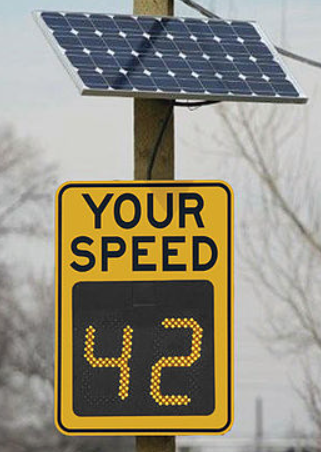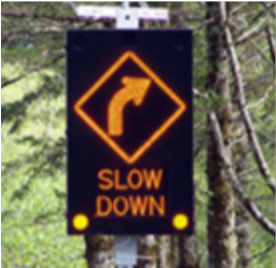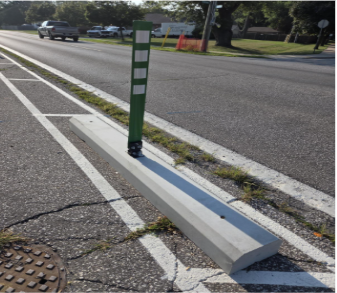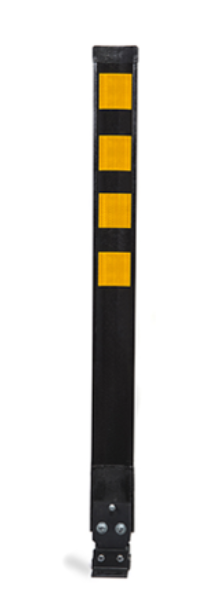Temporary Traffic Calming
Temporary traffic-calming measures are safety measures that can be implemented and removed rapidly with minimum civil work.
Temporary Traffic Calming Measures:
Radar Speed Feedback Signs

Advantages
- Inexpensive
- Does not require time for design
- Does not slow emergency vehicles
- Effective in reducing speeds in a short timeframe
Disadvantages
- Requires power source
- Only effective for one direction of travel
- Long-term effectiveness is uncertain
- Subject to vandalism
Vehicle Activated Warning Signs

Advantages and Disadvantages
- The advantages and disadvantages are the same as the radar speed feedback signs noted above.
Flexible Posts and Bollards

Advantages
- Narrows the road
- Reduces vehicle speeds
- If lanes are physically narrowed with the posts and bollards and space is not allocated to other travel modes, then there would be a reduced crossing distance for pedestrians.
- Quick implementation
- Less impact on traffic noise, fuel consumption, and emissions compared to speed humps
- No effect on emergency vehicles, resident access, snow plowing, street sweeping, and police enforcement
Disadvantages
- Cyclists may feel squeezed closer to vehicles if no bicycle lanes are provided.
- If paired with pavement markings, pavement markings require regular maintenance.
- Pavement markings may be less effective in the winter months due to snow/ice cover.
- Reduced separation between oncoming vehicles
On-Road Sign Pavement Markings

Advantages
- Inexpensive
- Quick implementation
- No increase in noise
- No impact to emergency vehicles, snow plowing, street sweeping, and police
- No adverse effect on vehicle operations
Disadvantages
- Requires regular maintenance
- May be less effective during winter months due to snow/ice cover
Traffic Calming Curbs

(Photo: Traffic calming curb with flexible bollard on South National Street, Windsor, Ontario)
Advantages
- Quick implementation
- If lanes are physically narrowed and space is not allocated to other modes, then there would be a reduced crossing distance for pedestrians.
- Minimal effect on emergency vehicles, resident access, street sweeping, and police enforcement
- Can act as a physical barrier between vehicles and cyclists or pedestrians
Disadvantage
- May affect snow plows, depending on the location, if placed during the winter season
Frequently Asked Questions (FAQ)
Do the radar speed feedback signs collect data?
Yes. The signs collect the speeds and volumes of traffic.
The radar speed feedback sign is dark without displaying speeds. Is it broken?
Not necessarily. The radar speed feedback sign may be on stealth mode, where it is working and collecting data but not displaying the speeds visibly on the screen.
How long will the posts/bollards be installed?
All flexible posts/bollards are removed at the start of the winter season.
What is the spacing between the posts/bollards?
Typically, the posts/bollards are placed approximately 100 metres to 200 metres apart.
Will the posts/bollards be placed near my driveway?
No. The posts/bollards are placed a minimum of 3 metres away from the edge of driveways.
Will the posts/bollards damage my vehicle if I hit them?
No. If a vehicle hits the post/bollard, the post/bollard will regain its upright position, causing little to no damage to the vehicle.
As a cyclist, where should I ride on the road if the roads are narrowed by the posts/bollards?
The posts/bollards are generally not placed on roads that are indicated as a signed bicycle route. If a bicycle lane or multi-use path/trail is present, the cyclist would be required to utilize the bicycle lane or multi-use path/trail.
Transportation Services
1266 McDougall Street
Windsor, Ontario, Canada, N8X 3M7
Hours of Operation: Monday to Friday (excluding holidays) 8:30 a.m. to 4:30 p.m.
For general information, please call 311. For detailed inquiries, please contact 311@citywindsor.ca via email.

